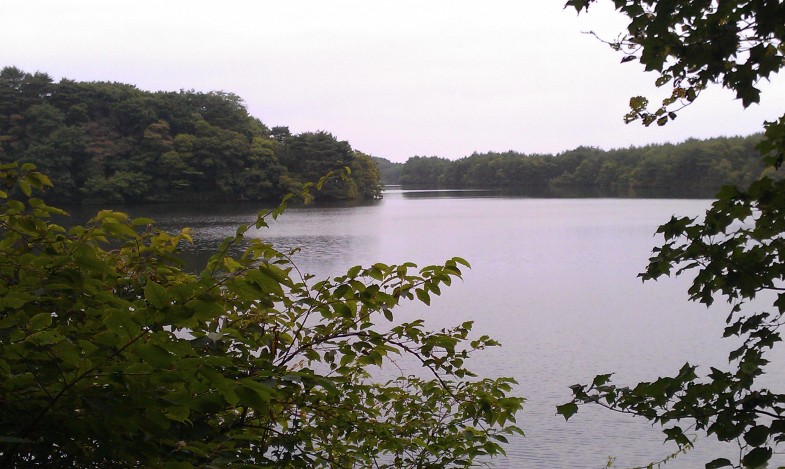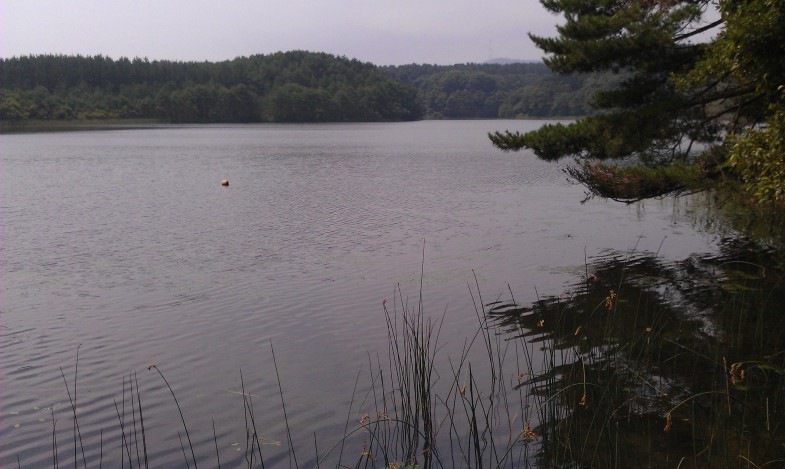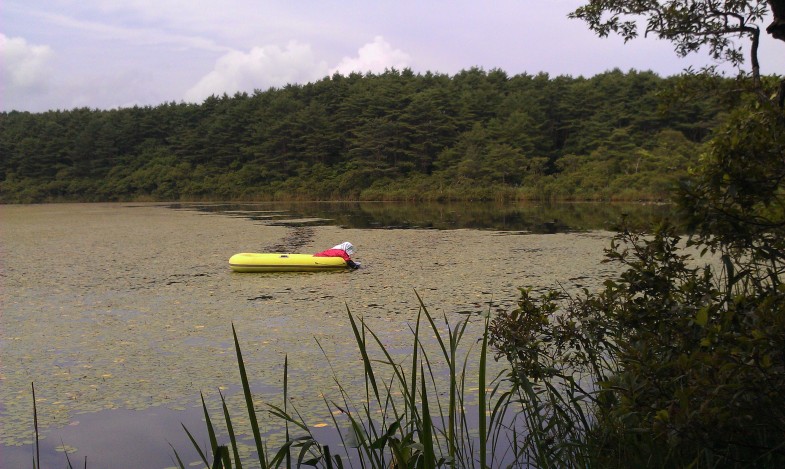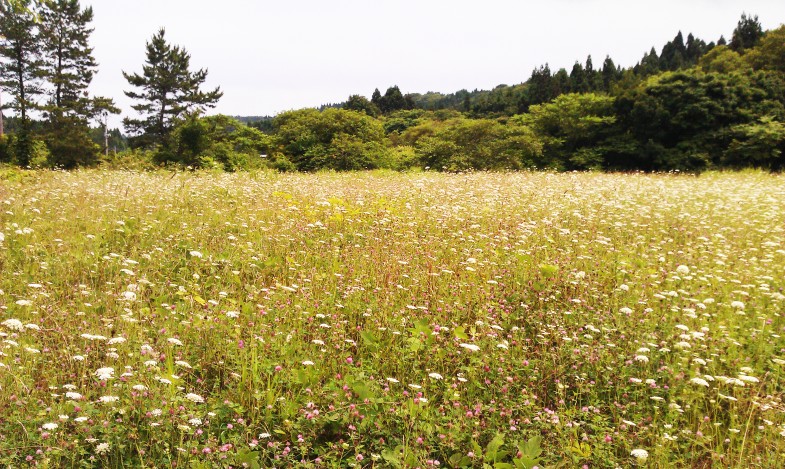


"ಸ್ಯಾಂಡ್ ಡ್ಯೂನ್ ಲೇಕ್" ಎಂದರೆ ಮರಳು ಕಡಲತೀರಗಳು ಗಾಳಿ ಮತ್ತು ಇತರ ಅಂಶಗಳಿಂದಾಗಿ ನಿರ್ಣಯಗಳನ್ನು ಸೃಷ್ಟಿಸುತ್ತವೆ.、ಇದು ಸಿಹಿನೀರಿನ ಜೌಗು ಪ್ರದೇಶವಾಗಿದ್ದು, ಖಿನ್ನತೆಗೆ ಹರಿಯುವ ನದಿಗಳಿಂದ ಸ್ವಾಭಾವಿಕವಾಗಿ ರೂಪುಗೊಂಡಿದೆ (ಉದಾಹರಣೆಗೆ ಸಾಗಾಟಾ, ನಿಗಾಟಾ ಪ್ರಿಫೆಕ್ಚರ್).。ಸಾಗರ ಪ್ರವಾಹಗಳು ಮತ್ತು ಅಲೆಗಳು ಮರಳು ಬ್ಯಾಂಕಿನಂತೆ ಏರಲು ಕಾರಣವಾಗುತ್ತವೆ ಮತ್ತು ನಿರ್ಗಮನವನ್ನು ನಿರ್ಬಂಧಿಸುತ್ತವೆ、ಇದು ಸಾರೋಮಾ ಮತ್ತು ಹಚಿರೋಗಾಟ ಸರೋವರದಂತಹ ಉಪ್ಪುನೀರಿನ ಸರೋವರಗಳಿಗಿಂತ ಭಿನ್ನವಾಗಿದೆ.)。ಮರಳು ಡ್ಯೂನ್ ಸರೋವರವು ಒಂದು ಅಮೂಲ್ಯವಾದ ಜೀವಿ, ಅದು ಪ್ರಪಂಚದಾದ್ಯಂತ ಕಳೆದುಹೋಗುತ್ತಿದೆ.、ಇದು ಜೈವಿಕವಾಗಿ ಅಮೂಲ್ಯವಾದ ವಾತಾವರಣವನ್ನು ಸೃಷ್ಟಿಸುತ್ತದೆ。
Sand dune lake is a natural freshwater pond in a sandhill. It was shaped by wind. The wind had been carring sand and formed ups and downs, and then water stream into hollow places. It is not only very valuable existence itself in the world but also it gives important environment for biodeversity that’s being lost.
ಹಿಗಾಶಿಡೋರಿ ಗ್ರಾಮದಲ್ಲಿ、ಅನೇಕ ದೊಡ್ಡ ಮತ್ತು ಸಣ್ಣ "ಡ್ಯೂನ್ ಸರೋವರಗಳು" ಇವೆ (ಜೌಗು ಪ್ರದೇಶಗಳ 13 ಹೆಸರುಗಳಿವೆ)。ಹಿಗಾಶಿಡೋರಿ ಗ್ರಾಮ, ಮಂಕಿ ಅರಣ್ಯ ಮರಳು ದಿಬ್ಬಗಳು ಮತ್ತು ಹಿಂಭಾಗದ ಗದ್ದೆಗಳನ್ನು ಜಪಾನ್ನ 500 ಪ್ರಮುಖ ಗದ್ದೆಗಳಲ್ಲಿ ಒಂದಾಗಿ ಆಯ್ಕೆ ಮಾಡಲಾಗಿದೆ (ಶಿಮೋಕಿತಾ ಪರ್ಯಾಯ ದ್ವೀಪದ ಹೆಚ್ಚಿನ ಭಾಗಗಳು ಈ ಆಯ್ಕೆಯನ್ನು ಸ್ವೀಕರಿಸಿವೆ ಎಂದು ಹೇಳಬಹುದು).。ಈ ಮಂಕಿ ಫಾರೆಸ್ಟ್ ಸ್ಯಾಂಡ್ ಡ್ಯೂನ್ (1-2 ಕಿ.ಮೀ ಅಗಲ)、ಒಟ್ಟು 17 ಕಿ.ಮೀ ಉದ್ದವನ್ನು ಸಂಯೋಜಿಸುವ ಶಿಮೋಕಿತಾ ಮರಳು ದಿಬ್ಬಗಳು ಮತ್ತು ಸ್ವಲ್ಪ ಒಳನಾಡಿಗೆ ಪ್ರವೇಶಿಸಿದ ಮರಳು ದಿಬ್ಬಗಳು、ಇದು ವಿರಳವಾಗಿ ತಿಳಿದಿದೆ, ಆದರೆ ಇದು ವಾಸ್ತವವಾಗಿ ಜಪಾನ್ನ ಅತಿದೊಡ್ಡ ಮರಳು ದಿಬ್ಬವಾಗಿದೆ.。ಅದು ತಿಳಿದಿಲ್ಲ、ಗಾಳಿ ನಿರೋಧಕ ಮತ್ತು ಮರಳು-ನಿರೋಧಕ ಕಾಡುಗಳು ಮರಳು ದಿಬ್ಬಗಳನ್ನು ಸುತ್ತುವರೆದಿವೆ.、ಜನರು ನೋಡುವುದು ಕಷ್ಟ、ಹೆಚ್ಚಿನ ರಕ್ಷಣಾ ಸಚಿವಾಲಯ ಮತ್ತು ಇತರರು ಇದನ್ನು ಬ್ಯಾಲಿಸ್ಟಿಕ್ ಪರೀಕ್ಷಾ ತಾಣಗಳಲ್ಲಿ ಬಳಸುತ್ತಾರೆ.、ಏಕೆಂದರೆ ಪ್ರವೇಶವನ್ನು ನಿಷೇಧಿಸಲಾಗಿದೆ。
There are many dune lakes in Higashi-dori village. Named lakes are minimum 13s. Salugamori sandhill (1~2 km width, 17 km length) include the rear wetland in this village has selected one of 500 of the important wetland of Japan (Actually most of Shimokita peninsula is selected also). Additionaly, Shimokita sandhill (includ this Salugamori sandhill with the next ones) is really the biggest one in Japan. However almost all japanese don’t know of it. One of the reason is that this place is hidden from the roads by pine grove for protect the wind and the sand. The other one, here is off limited, because this ares has been useing for test site of trajectory of Ministry of Defence (MD).
ಡ್ಯೂನ್ ಸರೋವರ ಸ್ವತಃ ರಕ್ಷಣಾ ಪ್ರದೇಶದ ಸಚಿವಾಲಯದ ಹೊರಗಿದೆ.、ಕೆಲವು ಮೀನುಗಾರಿಕೆಗೆ ಬಳಸಲ್ಪಟ್ಟಂತೆ ತೋರುತ್ತದೆ.。ಆದಾಗ್ಯೂ, ಗಾಳಿ ನಿರೋಧಕ ಮತ್ತು ಮರಳು ನಿರೋಧಕ ಪೈನ್ ಕಾಡುಗಳು ದೊಡ್ಡದಾಗಿ ಬೆಳೆದವು、ಜೌಗು ಪ್ರದೇಶಕ್ಕೆ ಹೋಗುವ ಅನೇಕ ರಸ್ತೆಗಳು ಕಣ್ಮರೆಯಾಗಲು ಪ್ರಾರಂಭಿಸಿವೆ。ಜನಸಂಖ್ಯೆಯ ಕುಸಿತ ಮತ್ತು ವಯಸ್ಸಾದವರು ಇಲ್ಲಿ ಪ್ರಗತಿ ಹೊಂದುತ್ತಿದ್ದಾರೆ、ಈಗ ಯಾವುದೇ ಶೈಕ್ಷಣಿಕ ಸಂಶೋಧನೆ ನಡೆಸಲಾಗುವುದಿಲ್ಲ.。
These are out of the area of MD. A few lakes of it look as useing fishery sometimes but not often. Most of the roads to go there is being lost by growing thickly weeds and pine grove. Creasing depopulation and ageing there. Academic reserch stopped now.
ಫೋಟೋ ಮೇಲಿನಿಂದ ಬಂದಿದೆ (ಉತ್ತರದಿಂದ ದಕ್ಷಿಣಕ್ಕೆ ಸಾಲಾಗಿರುತ್ತದೆ)、ಒಂದು ಬಗೆಯ ನಾಚಿಕ、ಸಕ್ಯೊನ್ಯೂಮ、ಅರನುಮ。ಗಾತ್ರ ಮತ್ತು ಆಳವು ಸ್ವಲ್ಪ ಬದಲಾಗುತ್ತದೆ, ಆದರೆ ಅವೆಲ್ಲವೂ ನೈಸರ್ಗಿಕವಾಗಿ ಉಳಿದಿವೆ.。ಒನುಮಾ ಒಂದು ತೆತಾಗ ಸೀಗಡಿ、ಸಕ್ಯೊನುಮಾ ಈ ಏಗಾಗ್ರೋಪಿಲಾ ಲಿನ್ನೇಗೆ ಹೆಸರುವಾಸಿಯಾಗಿದೆ.、ನಾವು ತನಿಖೆ ಮಾಡದ ಈಗ ಏನಾಗುತ್ತದೆ?。ಅರಾನುಮಾ 1-2 ಮೀ ಆಳ、ಇದು ಪ್ರಸ್ತುತ ಜುನ್ಸೈ (ಬ್ರಾಸೆನಿಯಾ ಶ್ರೆಬೆರಿ) ಆಯ್ಕೆ ಮಾಡುತ್ತಿದೆ.。
Photo:(above) O-numa. Small river prawn lives in. (midlle) Sakyo-numa. Sakyo-numa is famous for “Hime-malimo” (small moss ball), but how is it now? (bottom) An old woman was picking “Jun-sai” (the water shield) from the water at lake Ala-numa. ※numa means lake or pond. All of dune lakes are Nature.

